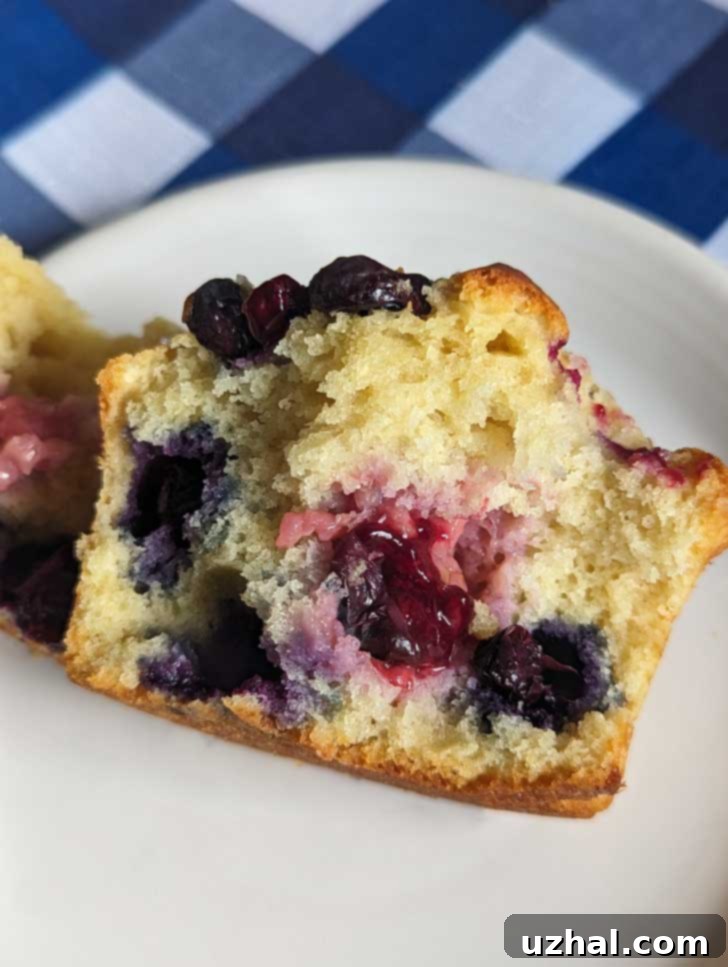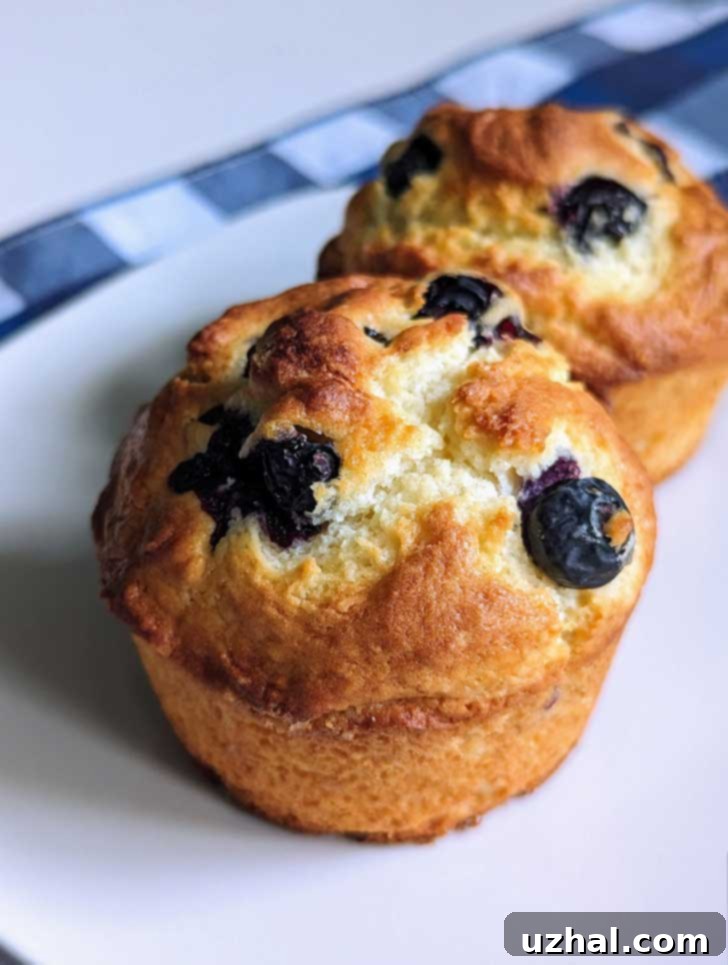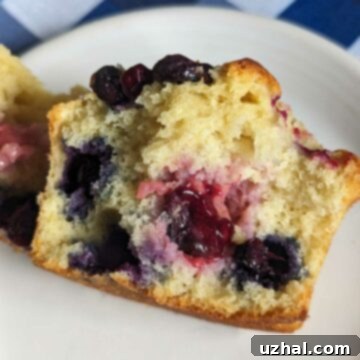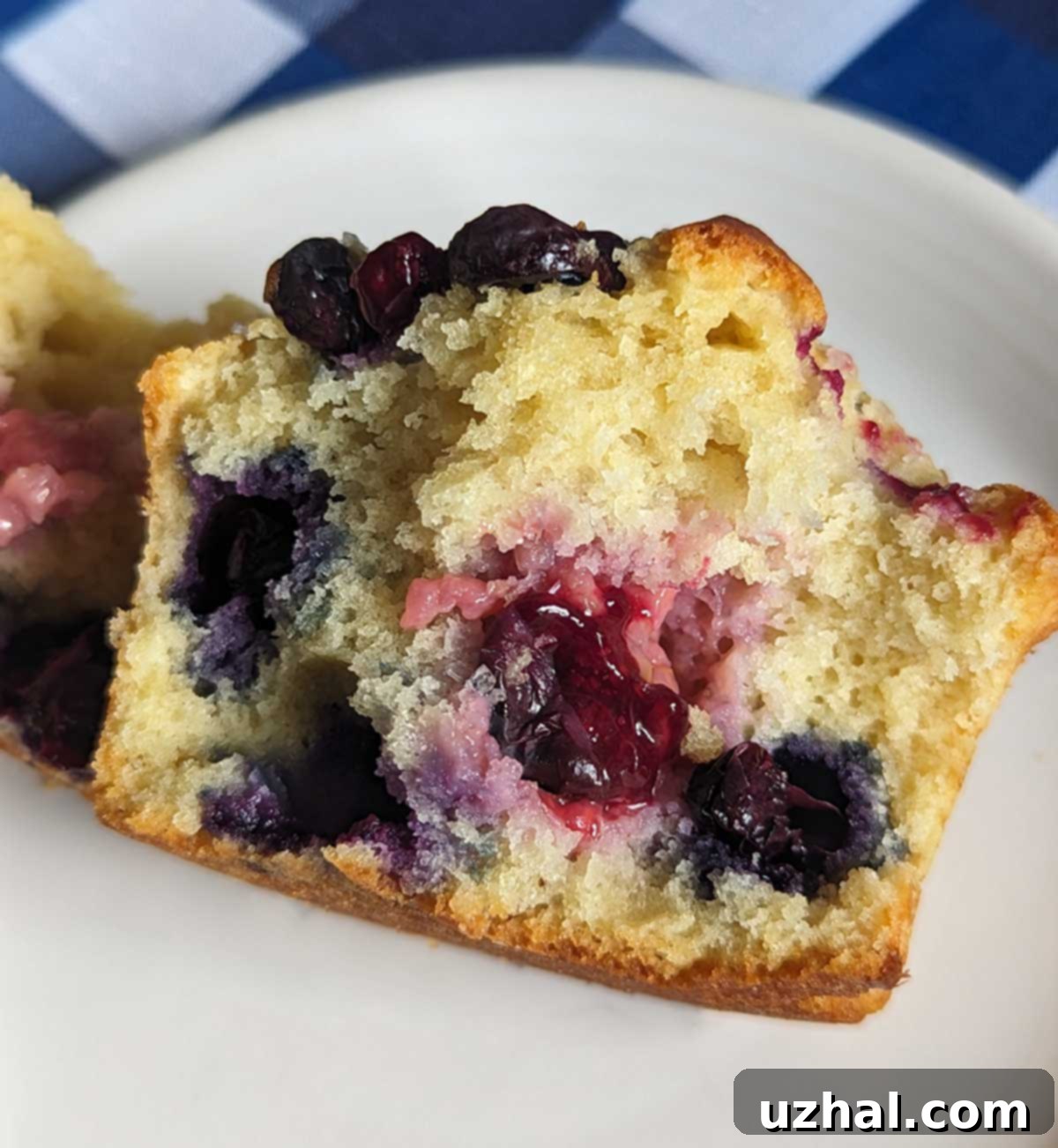Mastering Small Batch Muffins: Your Guide to Perfectly Baked Delights (Blueberry, Chocolate Chip & More!)
Welcome to the ultimate guide for creating irresistible small batch muffins! While we affectionately call these “Small Batch Blueberry Muffins,” this foundational recipe is so wonderfully versatile that it truly deserves to be known simply as “Small Batch Muffins.” Imagine waking up to the aroma of freshly baked goods, without the commitment of a huge batch. This recipe is designed to yield just 4 to 6 perfectly portioned muffins, making it ideal for smaller households, a spontaneous baking craving, or when you simply want to enjoy warm muffins straight from the oven.
Beyond blueberries, this flexible base welcomes an array of delightful additions. Think juicy raspberries, tart cherries, or decadent chocolate chips. Each variation brings its own unique charm, allowing you to customize your baking experience every time. These muffins are characterized by their impressive rise, a perfectly balanced sweetness that isn’t overpowering, and a satisfyingly substantial texture. They’re not light and airy like cupcakes; instead, they offer a comforting heft, perfect for a hearty breakfast or a wholesome snack. Best of all, this recipe is incredibly straightforward, promising a delightful baking experience even for novice bakers.

The Secret to a Taller Muffin: Letting the Batter Sit
One of the simplest yet most effective techniques I employ for these small batch muffins, regardless of the additions, is allowing the batter to rest before baking. This step, though often overlooked, can significantly impact the final texture and height of your muffins. After mixing all the ingredients, simply let the batter sit at room temperature for approximately 15 minutes before transferring it to the oven.
So, what’s the magic behind this resting period? In baking theory, letting muffin batter sit allows the flour to fully hydrate. When flour mixes with liquid, the starch granules absorb moisture. This hydration process continues as the batter rests, leading to a more consistent and tender crumb. Furthermore, resting the batter gives the gluten strands, which develop during mixing, a chance to relax. Overworked gluten can result in tough muffins, but a brief rest helps to tenderize them. Perhaps most importantly for that desirable “muffin top,” this pause allows the leavening agents (baking powder and baking soda) to begin their work more effectively once they hit the heat of the oven, resulting in a superior rise and a lighter, airier texture.
Some enthusiastic bakers even advocate for letting their muffin batter sit overnight in the refrigerator. While I haven’t personally experimented with an overnight rest due to my eager anticipation for fresh muffins, the theory suggests it could lead to an even higher rise and a deeper flavor development. For now, the 15-minute rest consistently delivers muffins that are far from flat, boasting a beautifully domed top and an inviting texture. It’s a small step that yields noticeable results, elevating your homemade muffins from good to truly great.
Boost Your Muffins: The Art of Adding Protein Powder
This small batch muffin recipe serves as an excellent foundational template, inviting all sorts of creative improvisations and nutritional enhancements. One of my favorite modifications involves incorporating protein powder. By swapping out just 2 tablespoons of all-purpose flour for 3 tablespoons of your preferred protein powder, you can subtly transform the muffins.
Adding protein powder offers several benefits. Firstly, it contributes to a more robust structure, helping the muffins stand taller and maintain their shape, even with the addition of moist fruits. Secondly, protein powder can encourage a richer, browner crust, adding to the visual appeal and enhancing the overall flavor profile through caramelization. Nutritionally, it gives your muffins a protein boost, which can help increase satiety and make them a more substantial breakfast or snack option.
When selecting protein powder, consider the type. Whey protein tends to absorb more liquid and can sometimes make baked goods a bit drier, so ensuring other wet ingredients are at room temperature or even slightly increasing the liquid could be beneficial. Plant-based protein powders (like pea or rice protein) can behave differently, often requiring similar adjustments. Regardless of your choice, the small substitution amount in this recipe makes it an easy and forgiving experiment. Beyond protein powder, this template is also amenable to other flour substitutions, such as a small portion of whole wheat flour for added fiber, or even a touch of almond flour for a slightly denser, nutty crumb. Always remember to adjust the liquid content slightly if making more significant flour changes, as different flours absorb moisture at varying rates.

The Role of Fat in Tender Muffins
Fat is a crucial component in any muffin recipe, contributing significantly to moisture, tenderness, and flavor. In this small batch recipe, I typically opt for a harmonious blend of softened butter and coconut oil. This combination isn’t arbitrary; it’s a deliberate choice to achieve optimal results.
Softened butter provides that classic rich, creamy flavor and helps create a tender crumb. Its solid state at room temperature contributes to the muffin’s structure. Coconut oil, especially unrefined virgin coconut oil, adds an extra layer of moisture and a subtle, delightful tropical aroma that pairs exceptionally well with the butter, creating a nuanced flavor profile. Using room temperature coconut oil ensures it blends smoothly into the batter without clumping. The unique fatty acid composition of coconut oil also contributes to a pleasant chewiness and aids in achieving that desired golden-brown crust.
However, the world of fats in baking is vast and open to experimentation. I’ve also had great success with a combination of butter-flavored oil and regular butter. This particular blend imparts a lovely yellow hue to the muffins, making them visually appealing while maintaining a rich, buttery taste. If you’re looking for alternatives, a neutral-flavored vegetable oil (like canola or grapeseed) can be used for a simpler approach, offering moisture without introducing strong flavors. For a lower-fat option, some bakers substitute a portion of the fat with unsweetened applesauce, though this might slightly alter the texture and require minor adjustments to other ingredients to maintain moisture. The key is to understand that fat carries flavor, tenderizes the crumb, and helps with browning, making it an indispensable element in crafting truly delicious muffins.
Sweetening Your Muffins: Sugar and Alternatives
Sugar plays a multifaceted role in muffin baking, extending far beyond simply adding sweetness. It contributes to the overall moisture of the muffin, helps in achieving that beautiful golden-brown crust through caramelization, and tenderizes the crumb. For this particular small batch muffin recipe, I generally wouldn’t recommend going lower than ¼ cup of sugar, as this amount is crucial for both taste and structure. Reducing it too much can result in a drier, less flavorful muffin that doesn’t brown as well.
However, if you’re mindful of sugar intake or prefer alternative sweeteners, this recipe is quite adaptable. I’ve successfully tested these muffins with a product called Magic Baker. This particular sweetener, produced by Splenda, is noteworthy because it does *not* contain sucralose, which is a common artificial sweetener. Instead, it’s a thoughtful blend of erythritol, allulose, and stevia. Erythritol provides bulk and structure, allulose offers a sugar-like taste and texture with fewer calories, and stevia adds concentrated sweetness. This combination works harmoniously to mimic sugar’s properties in baking, resulting in muffins that are still sweet, moist, and well-structured, but with a significantly reduced sugar content.
When experimenting with other sugar alternatives, it’s essential to understand their properties. Some, like erythritol, can have a cooling sensation if used in large quantities. Others, like monk fruit or xylitol, might have different bulk and sweetness levels compared to granulated sugar, potentially requiring adjustments to the overall liquid or dry ingredients to maintain the correct batter consistency. Always read the manufacturer’s recommendations for baking conversions. Regardless of your choice, ensuring your sweetener contributes adequately to both the sweetness and the structural integrity of the muffin is key to a successful bake.
Fresh, Frozen, or Chocolate Chips: The Perfect Muffin Mix-Ins
While these are famously known as Small Batch Blueberry Muffins, the beauty of this recipe lies in its adaptability to a wide array of mix-ins. Whether you’re a fan of fresh fruit or crave something a bit more indulgent, this base recipe is ready to accommodate your preferences.
For fruit additions, fresh blueberries are always a fantastic choice, bursting with natural sweetness and a slight tartness. If fresh blueberries aren’t in season or readily available, frozen blueberries can certainly be used, but with a critical caveat: they must be thawed and gently patted dry beforehand. Baking with straight-from-the-freezer berries is not recommended for this recipe, as they tend to release excess liquid as they bake. This additional moisture can throw off the delicate balance of the batter, leading to soggy muffins or causing the berries to sink to the bottom. Patting them dry helps to mitigate this issue, ensuring your muffins remain light and fluffy.
Beyond berries, the possibilities are endless. Chocolate chips are a universally beloved addition, transforming these into a delightful sweet treat. You can use milk, semi-sweet, or dark chocolate chips depending on your preference. For an extra layer of flavor and texture, I often combine chocolate chips with a small handful of chopped walnuts – the slight bitterness and crunch of the nuts perfectly complement the sweetness of the chocolate. Other fantastic mix-in ideas include chopped raspberries, diced apples, cranberries (fresh or dried), lemon zest for a bright citrusy note, or even a dash of cinnamon or nutmeg for a warm spice profile. When adding heavier mix-ins like nuts or larger fruit pieces, consider tossing them lightly in a tablespoon of flour before adding them to the batter. This trick helps to create a thin coating that prevents them from sinking to the bottom of the muffin cups, ensuring an even distribution throughout each delicious bite.
Essential Baking Tips for Small Batch Muffins
Achieving bakery-quality muffins at home is simpler than you think, especially with a small batch recipe. Here are a few indispensable tips to ensure your muffins turn out perfectly every time:
- Don’t Overmix: This is perhaps the golden rule of muffin making. Once you combine the wet and dry ingredients, mix just until no streaks of dry flour remain. Overmixing develops gluten too much, leading to tough, chewy muffins instead of light, tender ones. A few lumps in the batter are perfectly acceptable!
- Room Temperature Ingredients: Ensure your egg, milk, and softened butter/coconut oil are at room temperature. This allows them to emulsify better, creating a smoother, more uniform batter and contributing to a better rise and finer crumb.
- Properly Fill Muffin Cups: For beautifully domed muffin tops, fill your muffin cups generously, about two-thirds to three-quarters full. If using liners, make sure they are well-seated in the muffin tin. For extra tall muffins, you can even fill them to the brim, especially if you’re using silicone liners or a well-greased non-stick pan.
- Preheat Oven Thoroughly: A hot oven from the start is crucial for activating the leavening agents quickly, which helps in achieving that initial burst of rise. Ensure your oven is fully preheated to the specified temperature before placing the muffins inside.
- Test for Doneness: Muffins are typically done when they are golden brown on top, feel firm to the touch, and a wooden skewer or toothpick inserted into the center comes out clean or with moist crumbs attached (not wet batter). Overbaking can lead to dry muffins, so keep a close eye on them towards the end of the baking time.
Storage and Reheating: Keeping Your Muffins Fresh
One of the joys of small batch baking is enjoying freshly made goods, but knowing how to store and reheat them properly ensures you can savor their deliciousness for longer.
- Room Temperature Storage: Once completely cooled, store your muffins in an airtight container at room temperature for up to 2-3 days. To prevent them from becoming soggy, you can place a piece of paper towel at the bottom of the container to absorb any excess moisture.
- Freezing for Longer: Muffins freeze exceptionally well. Allow them to cool completely, then place them in a single layer on a baking sheet and freeze until solid (about 1-2 hours). Once frozen, transfer them to a freezer-safe bag or container. They can be stored in the freezer for up to 2-3 months. Freezing individually prevents them from sticking together.
- Reheating:
- From Room Temperature: Pop a muffin into the microwave for 15-30 seconds, or in a toaster oven at 300°F (150°C) for 5-10 minutes, until warmed through.
- From Frozen: Reheat frozen muffins in a preheated oven at 300°F (150°C) for 15-20 minutes, or until warmed through. You can also microwave them from frozen for 30-60 seconds, checking periodically.
Reheating them slightly can bring back that wonderful fresh-baked aroma and tender texture, especially if they’ve been sitting for a day or two. A quick toast can also revive their delightful qualities, making them feel brand new.
Here’s the recipe that makes all these delicious variations possible!
- Chocolate Chip Peanut Butter Protein Cookies
- Fuzz’s Gingerbread Muffins
- Sweet Potato Protein Powder Muffins
- Blueberry Muffin Squares
- Blueberry Chocolate Chip Cookies
Recipe: Small Batch Blueberry Muffins

Small Batch Blueberry Muffins
Anna
Pin Recipe
Ingredients
- 1 cup all-purpose flour (135-140 grams)
- 1 teaspoon baking powder
- ¼ teaspoon baking soda
- ¼ teaspoon salt
- 2 tablespoons butter, softened (28 grams)
- 2 tablespoons coconut oil, room temperature or any neutral oil (26 grams)
- ¼ cup sugar (50 grams)
- 1 large egg
- ¼ cup milk, room temperature (56 grams)
- ½ teaspoon vanilla extract and/or a few zests of lime or lemon
- 1 cup blueberries, or more or less as desired
Instructions
-
Begin by preparing your muffin cups. You won’t preheat the oven yet, as the batter needs a crucial resting period. Line 4 to 6 muffin cups with paper liners. The number of muffins will depend on your desired size. Alternatively, for an eco-friendly approach, use a silicone muffin pan without liners. While you can grease a metal pan directly, muffins tend to rise more impressively when baked in paper or silicone liners, yielding those coveted tall tops.
-
In a medium mixing bowl, thoroughly combine the dry ingredients: all-purpose flour, baking powder, baking soda, and salt. Use a whisk or fork to stir until these ingredients are evenly blended. This step is vital to ensure proper leavening and consistent texture, as minimal mixing will occur once the wet ingredients are added.
-
In a separate, larger mixing bowl, cream together the softened butter, room temperature coconut oil (or your chosen neutral oil), and sugar. Use a heavy-duty scraper or a sturdy spoon to mash and stir until the mixture is light, fluffy, and evenly blended. Next, incorporate the room temperature large egg, milk, and vanilla extract. If using, also add a few zests of lime or lemon at this stage for an extra burst of fresh flavor. Mix well until everything is thoroughly combined.
-
Add the combined dry flour mixture to the wet ingredients. Gently fold them together using your scraper or spoon, stirring just until the flour is incorporated and no visible dry streaks remain. It’s perfectly fine if there are a few small lumps; overmixing will result in tough muffins. Resist the urge to add the blueberries or other mix-ins at this point.
-
Now it’s time for the blueberries! Spoon a generous, heaping tablespoon of batter into each of your 4 to 6 muffin cups. Sprinkle a few blueberries on top of this first layer of batter. Then, add more spoonfuls of batter, alternating with sprinkles of blueberries, until the muffin cups are about two-thirds to three-quarters full. This layering technique helps ensure an even distribution of berries throughout each muffin.
-
While your muffin batter rests in the cups, preheat your oven to 400ºF (200ºC). The 15-minute resting period for the batter, which should coincide with the oven preheating time, is crucial. This rest allows the flour to fully hydrate and the leavening agents to begin their work, setting the stage for perfectly risen, tender muffins.
-
Once the oven is fully preheated and the batter has rested, place the muffin tin into the hot oven. Bake for 18 to 20 minutes. You’ll know they’re ready when they achieve a beautiful golden-brown color, the tops are wonderfully cracked, and they feel firm to the touch. A toothpick inserted into the center should come out clean. Allow the muffins to cool in their cups for about 10 minutes before carefully removing them. They can be served warm, straight from the oven, or allowed to cool further. Many find that the texture, particularly the tenderness of the crumb, improves slightly as they sit. If serving later, you can easily re-warm them in a microwave or toaster oven for that fresh-baked feel.
Notes
